Simulation settings
Under the "Settings" tab you can modify the simulation settings.

There are two types of solvers available in Treble.
- The wave-based solver - based on discontinuous Galerkin finite element method shortnamed as DGFEM.
- The geometrical acoustics solver - based on a combination of the image source method for early reflection modeling and the ray-tracing method for late reverb modeling.
The geometrical acoustics solver is better suited for high frequencies, whereas the wave-based solver solves the wave equation and gives accurate results at all frequencies. It does, however, take longer time to compute, especially for high frequencies and large rooms. It is therefore a reasonable approach to use a hybrid of the wave-based solver and the geometrical acoustics solver.
Survey
This option will only use the geometrical acoustics solver as a fast calculation method. Consequently the transition frequency cannot be changed. The impulse response length will be set based on an initial estimate of the reverberation time that depends on the materials assigned.

Default
This option will use a hybrid solver, the wave-based solver for low frequencies and the geometrical acoustics solver for high frequencies. Note that in order to use the wave-based solver the geometry has to be watertight.
The model will be analyzed and an optimal transition frequency will be provided automatically. The impulse response below the chosen transition frequency will be calculated using the wave-based solver, whilst the impulse response above the transition frequency will be calculated using the geometrical acoustics solver, and then combined (or hybridized).
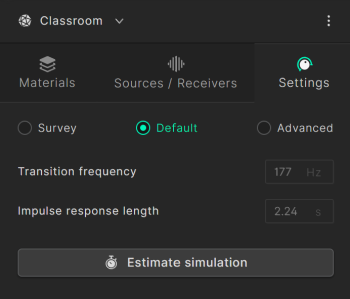
Advanced
This option allows the you to modify the given parameters:
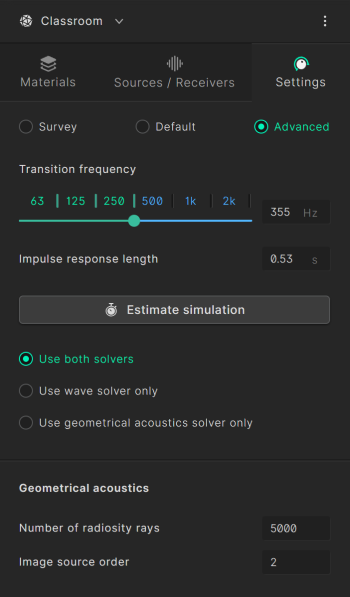
The transition frequency can be modified using the slider or clicking on a octave band (above the slider). When selecting an octave band, its upper cutoff frequency will be set as the transition frequency, as shown to the right of the slider. For example if 500Hz octave band needs to be simulated by the wave-based solver, the transition frequency is 710 Hz.
The wave-based solver is accurate but takes longer time. Note that the simulation time does not increase linearly with the transition frequency but rather as a fourth order polynomial function of the transition frequency.
The termination criterion allows for defining one of two different ways of when the simulations should stop. Either when the energy at each receiver has dropped by an energy decay threshold value (defined in dB), or when the simulated IR has reached a certain signal length (defined in s).
As previously stated, it is possible to run a simulation using both solvers. A simulation can also be ran with only the wave-based solver. If that option is selected it will only contain results from the 63 Hz octave band up to the transition frequency. It is also possible to run a simulation with only the geometrical acoustic solver, in which case results will be calculated for the 125 - 8000 Hz octave bands.
-
Image source order: The highest reflection order considered by the image source algorithm for early reflection modeling. Note that for most simulations the recomended image source order is 3, which is the default. The maxmium value is 10.
-
Number of rays: The number of rays used in the geometrical acoustics solver. Larger and more complex geometries typically require more rays for more accurate simulation results, however the ray-tracing part of the GA solver utilizes ray radiosity methods for tracing the energy which does not require a large amount of rays, therefore it is recommended to set the number of rays between 20.000 to 100.000 in most cases. The maximum value is 1.500.000 rays.
Run simulation
A simulation can be started by clicking the Run button.
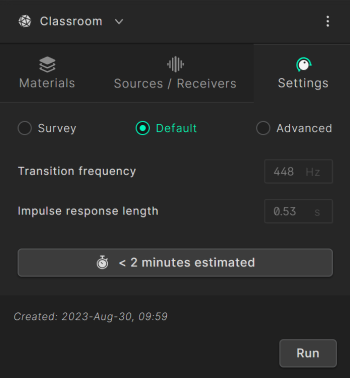
Then press the Start button in the window that opens up. This sends the job to the Treble cloud service for calculation. The cloud resources allocation usually takes a few seconds. When the simulations have started it is possible to minimize the Run simulation window.
You can create, edit and run new simulations while waiting for another simulation to finish. Once the simulation is completed it is possible to view the Results or listen to how your space sounds using the Auralizer.
Edit, revert and duplicate a simulation that has been run
For existing simulations, it is possible to either edit a selected simulation and run it again (overriding previous results), or to duplicate it with changed settings.
When changing materials, scattering, sources, receivers or settings of a selected simulation that has been run, a prompt window will appear giving you the option of either Editing the selected simulation or to Duplicate it.
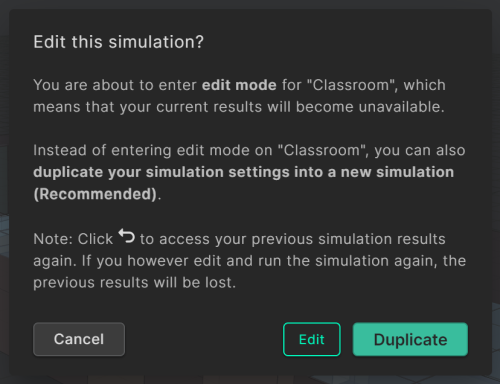
If Edit is selected the Edit mode will start, in which the simulation can be edited as required to run a simulation again. Note that if the simulation is run again after editing, it overrides the previous simulation results. While in edit mode, it is not possible to access previous results or to use the Auralizer.
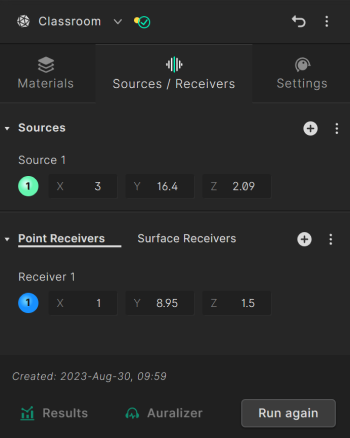
It is possible to exit the Edit mode in case it is not required to run the simulation again by selecting the Revert button in the right corner. Reverting will cancel the changes that were made in the Edit mode and go back to the settings of the previously run simulation, making the Results and Auralizer enabled again. A prompt window will appear asking for a confirmation to Revert from the changes that were made.
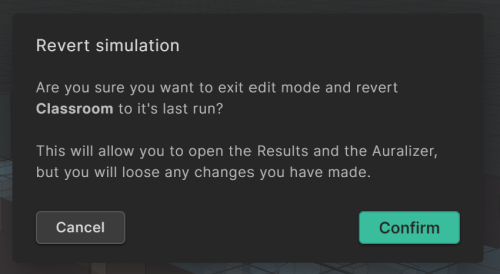
It is also possible to Duplicate an existing simulation instead of editing it by selecting the Duplicate button when prompted in the Edit window (see Edit Mode Picture above). This creates a new simulation based on the selected simulation, adding " - Copy" to the end of its name. This Duplicate simulation will also include the change made in Edit Mode.
Run status
To inspect the simulation progress click on Show run status.
This is the Simulation run view. The process for each source is shown in the drop-down.
